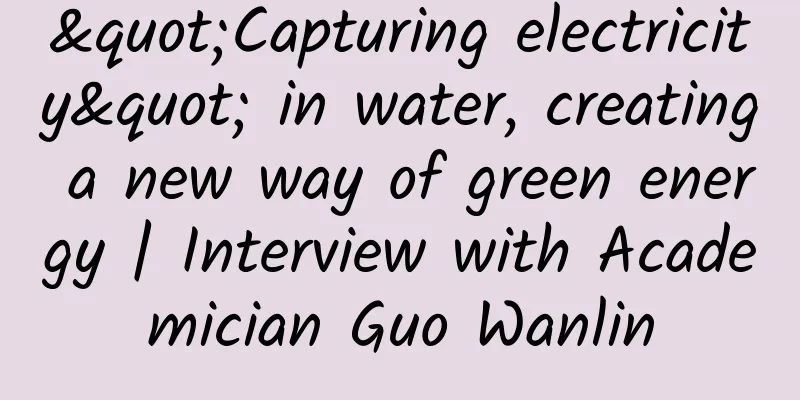"Capturing electricity" in water, creating a new way of green energy | Interview with Academician Guo Wanlin

|
As the world's largest hydroelectric power station, the Three Gorges Dam Project provides 1 billion kilowatt-hours of electricity every day to ten provinces and cities in East China. But under the pressure of rising energy demand and climate change, its energy output still does not meet the hopes of Nikola Tesla, the inventor of hydroelectric power generation technology. Tesla once said: "Electricity is everywhere and inexhaustible; it can drive mechanical equipment all over the world without relying on any fuel." The core of hydrovoltaics invented by Professor Guo Wanlin, Director of the Institute of Nanoscience at Nanjing University of Aeronautics and Astronautics and Academician of the Chinese Academy of Sciences, is to generate electricity through processes such as water evaporation and the movement of water droplets on the surface of nanomaterials. National Science Review recently interviewed Academician Guo to give an in-depth introduction to hydrovoltaics and look forward to the potential of this technology in the field of transitioning from fossil energy to renewable energy. NSR : Thank you for accepting our interview. How did hydrodynamics originate from your research on aerospace materials? Guo Wanlin : I graduated from the Department of Aeronautical Engineering at Northwestern Polytechnical University. I have been engaged in research on aerospace material structural engineering for many years. Aircraft manufacturing has used metal materials such as steel since the 19th century, and aerospace engineers subsequently began to study the strength of such materials and the safety of aircraft structures. They found that alloys such as steel can also fatigue and break after repeated loads. The concept of fatigue used to exist only in life sciences, but metals can also fatigue. Previous studies have shown that the reason for metal fatigue is that these materials produce uneven local strains under external stress. Because aircraft materials must be both strong and tough, uneven local strains are necessary. However, unevenness also causes the accumulation of plasticity, which ultimately leads to the breaking of chemical bonds in metal materials. Going deep into the atomic and quantum scales, electrons connect atoms into molecules, thus forming materials at the macroscopic scale. Our research on fatigue and fracture of aerospace materials over the past 30 years has guided us to a new research direction. In the process of transitioning from mechanics at the macroscopic scale to quantum mechanics at the microscopic scale, we discovered phenomena in hydrodynamics. For example, carbon nanotubes can stretch 20% under the action of an external electric field. Other in-depth experiments have also shown that external forces, heat, and magnetic fields can change the quantum state of the distribution and orbital properties of electrons in materials. These changes usually start at the interface between different regions inside the material. Specifically, the toughness of a material depends on the interaction at the internal interface. As an aerospace university, we naturally focused on the interface between aircraft engines and air, and we studied the relationship between this interface and engine thrust. We then extended our experiments to the interaction between functional materials and water, and studied the interaction of water flow, droplet motion, and evaporation with electrical charges. The human living environment includes steps of the water cycle such as evaporation, precipitation, rivers, and ocean waves. These processes absorb energy from the sun. When we convert this energy directly into electricity through the interaction of water with materials, we name it "hydrovoltaics", similar to photovoltaics. In short, our research trajectory started from fatigue and fracture at the macroscopic level and extended to the microscopic properties of solid interfaces, such as multi-field coupling. We then turned our attention to solid-liquid interfaces and discovered hydrovoltaics. Figure 1: Electron micrograph of the hexagonal crystal structure of graphene NSR : Could you please introduce the first step of the hydrovoltaic experiment that appeared in 2014? How did you discover that a liquid droplet can generate an electric potential when sliding on a graphene surface? Wanlin Guo : One of our students conducted an experiment involving frictional electricity generation between an air stream and a graphene surface and then decided to do a similar experiment in liquid. Previous experiments with carbon nanotubes in liquid did generate electricity, but our initial experiments with graphene in a stream of water did not work. However, when we took the graphene out of the liquid and across the air-liquid interface, we detected a voltage. Furthermore, when a droplet slid along the graphene surface, we detected a voltage that was proportional to the speed of movement. This discovery attracted considerable attention around the world when it was published in 2014. NSR : The next step in this research direction is to explain the mechanism of this phenomenon. What is the role of graphene in this process? Guo Wanlin : According to classical electrodynamics theory, at the solid-liquid interface, negative charges accumulate on the solid surface, and they attract positive ions in the liquid to the interface, which is called an adsorption layer. The negative ions in the liquid then form a diffusion layer next to the adsorption layer of the positive ions. In addition, the positive ions also attract a large number of electrons to the surface in the solid, and they form a capacitor-like structure. If a droplet moves along the surface of a solid, the capacitor-like structure will continue to charge in front of the droplet and discharge behind it. This cycle generates electron movement and potential difference in the solid. The positive and negative ions in the liquid form a classic double-layer system, and a third type of electron needs to be included in the solid to explain the potential generated before and after the droplet. This three-type charge model represents the extension of electrodynamics to energy harvesting. NSR : What are the factors that affect the voltage and power in hydrovoltaic experiments? How to optimize these parameters? Wanlin Guo : When we first started experimenting with droplet motion, the output voltage was on the order of millivolts. The output power was on the order of nanowatts. However, if we polarize the system with a bias voltage, we can increase the potential generated by the graphene. By optimizing the circuit, the output voltage increased again to about one volt. Next, we placed the droplet on a dielectric surface, and the diffusion of the droplet formed a capacitor. The charge on the capacitor is released to the external circuit, and the output is on the order of hundreds of volts. This progress from millivolts to volts to hundreds of volts was achieved in less than 10 years. In our recent experiments, the output voltage reached 1,200 volts when the droplet fell tens of centimeters from the tap. Figure 2: A sliding water droplet (right) generates a charge difference between its front and rear ends; a stationary water droplet (left) has balanced charges at both ends. NSR : The next step in hydrovoltaic research is electricity generation based on water evaporation. How does it work? How does its efficiency compare to the process of droplet motion? Guo Wanlin : Water on Earth receives 70% of the solar radiation energy, half of which is used for evaporation. As climate change intensifies, the evaporation process increases, so the water cycle process contains huge energy that can be used to generate electricity. We designed an experiment to demonstrate this process: we placed a strip of porous carbon material on a quartz substrate. Then we connected a series of electrodes on the edge of this strip of material and immersed half of it in water. The natural capillary effect draws water to the material, and the water-wetted area rises along the strip. The voltage distribution of different areas we measured shows the characteristics of this phenomenon: there is no voltage between the lowest two electrodes immersed in water, and there is no voltage between the highest two electrodes above the capillary range. Each part within the capillary range shows a gradually increasing voltage, and the sum of all parts adds up to the total voltage between the two ends of the strip. Based on our previous experiments with mobile droplet power generation, our hypothesis is that the basic mechanism of this process is the flow of water in the strip that maintains the source of evaporating water. The following series of experiments showed us the correlation between the voltage we measured and the evaporation of water. First, when the water was completely sealed in the container, the voltage generated by evaporation disappeared within 1000 seconds; when the container was opened, the voltage recovered. In addition, the voltage was affected by environmental conditions. Wind, increased temperature and decreased humidity increased the output voltage. In the natural environment, as climate change continues to intensify, we should make full use of these factors to optimize the efficiency of evaporation power generation, extracting the most energy from sunlight and converting it into electricity. If hydrovoltaic power generation is successfully implemented on a large scale, this technology may mitigate the effects of climate change and provide electricity. NSR : One of the latest advances in your research is the design of a composite material that combines moisture absorption and evaporation. To what extent can this improve the efficiency of the hydrovoltaic process? Guo Wanlin : The challenge that water evaporation power generation may face is its sustainability in the natural environment. For example, in areas without water sources such as lakes or rivers, the source of water for water evaporation must be the atmosphere itself. As the climate warms, the humidity of the atmosphere is also higher. To take advantage of this, we proposed a device that combines hygroscopic and evaporative. The hygroscopic function is achieved by the hygroscopic layer on the cellulose paper filled with lithium chloride; the evaporative function is achieved by the hydrophobic layer of the cellulose paper doped with carbon black. This composite device achieves hygroscopic function through lithium chloride and evaporative function through carbon black, forming a self-sufficient water cycle. At the same time, the hygroscopic process releases heat, and the evaporative process absorbs heat from the environment, forming a thermal cycle. This device can increase the power generation efficiency by 10 times, with an output voltage of volts and an output current of milliamperes. Figure 3: Water evaporation generates a voltage difference between the two ends of a carbon black strip (left). The double-layer composite material achieves water absorption and evaporation at the same time (right). NSR : Could you briefly introduce the latest developments in hydrovoltaic materials? Wanlin Guo : We used graphene in the droplet experiments and carbon black in the evaporation experiments. They are both carbon nanomaterials. Soon the materials we used expanded to include semiconductors, metal organic frameworks, and biomaterials such as protein membranes. They can all serve as hydrovoltaic materials. The first step in hydrovoltaic research is to discover these processes and find which materials can trigger them. The next step is to select which materials are more efficient and inexpensive. For example, the flake graphene used in the early droplet experiments was transferred to a fiber substrate. The process of transferring graphene caused inconsistencies in quality and number of layers. Later, we achieved the direct synthesis of graphene on a dielectric substrate and optimized the process using copper acetate as a catalyst in the chemical vapor deposition method. This greatly improved the quality of graphene and made hydrovoltaic materials more suitable for mass production. NSR : A core issue of photovoltaic conversion is efficiency. What is the current efficiency of hydrovoltaic conversion? Wanlin Guo : In the field of photovoltaics, the theoretical maximum efficiency is slightly above 30%. We are approaching this limit through the combination of silicon and perovskite technology. In less than 10 years of hydrovoltaics development, we have increased the efficiency from 1/1000 to 10%. When we converted the mechanical energy of water droplets to generate electricity, the experimental efficiency increased from about 10% to 20%. Unlike water evaporation, electricity generation is a natural process that does not require external work. The evaporation process continues in the water cycle, and the amount of energy converted is only limited by the conversion technology. In theory, we measure our conversion efficiency in terms of electrical power output per unit area, and the current value is about 1 watt per square meter. In terms of the energy conversion efficiency of evaporation, if we use all the heat absorbed by liquid water as the denominator, the efficiency is only about 1/1000, because most of the heat is used for the phase change of water from liquid to gas. Therefore, there is still a lot of room for optimization. If we can improve this ratio to 1%, we will enter a new era of hydrovoltaic energy. NSR : Another recent research topic of yours is aquatic intelligence. Please tell us about its relationship with neuroscience. Guo Wanlin : We predict that hydrovoltaics will further develop into three branches: hydrovoltaic energy, hydrovoltaic ecology, and hydrovoltaic intelligence. Our world has developed from the mechanical age to the electrical age, and then to the information age. Now we are transitioning to the intelligent age. When we study the source of intelligence, we find that the human brain contains 70% to 80% water. Our neural network is composed of billions of neurons, each of which also contains 70% to 80% water. How does such a system receive stimuli, release electrical signals, store memories, and ultimately form consciousness? This is an important area for future scientific research to focus on as we transition from the information age to the intelligent age. What we learn from the human brain may guide the development of artificial intelligence. According to classical neuroscience, electrical charges and neural signals in the brain originate from the movement of potassium, sodium, and calcium ions in water. However, the current understanding of ion dynamics cannot fully explain how the brain generates, stores, and processes information. In hydrovoltaics, we study the interaction between water and solids from the quantum mechanical scale to the atomic scale to the biomolecular scale, and we find that the movement of ions in the brain is regulated or controlled by water. This research direction will combine physics, chemistry, and biology. I think the future of neuroscience will definitely focus on this area. NSR : You also study the interaction between neurotransmitters and cell membranes. How did your research transition from artificial two-dimensional materials such as graphene to natural thin films? Wanlin Guo : In basic scientific research, we often study materials and processes in nature. When we study the activities that occur on cell membranes, the basic mechanisms are very similar to hydrovoltaic experiments that use artificial materials to generate electricity. These processes all focus on the interaction between electrons and ions at the interface between water and solids. We start from the same class of scientific principles from microscopic electronic properties to macroscopic electromagnetic fields and thermal properties. Specifically in the study of cell membranes, we know that cell membranes play a central role in the evolution of life as regulators of the flow of substances and information into and out of cells. These behaviors are performed by various proteins on the cell membrane. For example, we recently discovered that neurotransmitters such as dopamine, endorphins, and leucine endorphins have aromatic side rings that allow them to freely penetrate the membranes of neurons. In contrast, acetylcholine and aspartic acid do not have aromatic side rings and can only diffuse in the extracellular solution. This functional distinction is achieved by proteins embedded in the phospholipid bilayer of the cell membrane. NSR : Structural biologists have studied the functions of molecules on cell membranes, such as charge transport. What new insights can hydrovoltaics provide in this regard? Wanlin Guo : Classical biology first developed into cell biology, which then led to molecular biology with the discovery of genes and how genes produce proteins. Cryo-electron microscopy showed us the structure of proteins, and now we are in the era of structural biology. After seeing the structure, the next step is to understand the connection between structure and function. Specifically, in neuroscience, we want to understand how neurons store and process information. Hydrodynamics takes neuroscience one step further, focusing on how proteins interact with ions and molecules in the natural environment of neurons. This is crucial to understanding the transmission of substances and information in the brain. NSR : What insights can we gain from natural materials such as cell membranes when synthesizing artificial materials? Guo Wanlin : As we said, an important role of cell membranes is to regulate energy transfer and ion transport. In hydrogen fuel cells, the key function of proton exchange membranes is very similar to that of cell membranes. In lithium batteries, regulating ion transport is also the key to improving performance without damaging internal components. Membrane engineering is now an important direction in renewable energy research. NSR : What do you think are the main milestones in hydrovoltaics and when will they reach practical application? Guo Wanlin : When we started the droplet experiment in 2014 and the evaporation experiment in 2017, we only measured very weak effects. Since 2020, we have successfully increased the power output by 6 orders of magnitude and the evaporation power output by 3 orders of magnitude. We have achieved exponential growth in a few years. Following this trend, I predict that we may achieve breakthrough progress in the next 3 to 5 years. However, we must admit that it took about 100 years for traditional technologies, such as hydropower and photovoltaic power generation, to reach today's commercial applications. It is impossible to predict the development of scientific breakthroughs before they occur. But we believe that this field will definitely promote new discoveries in physics and chemistry. In addition, in the process of climate change, the heat and humidity in the environment are also increasing, so humans should invest more resources in developing technologies to extract energy from the environment. Hydrovoltaics may become a huge source of energy. As for the prospects of hydrovoltaic intelligence, we believe that the success of artificial intelligence depends on what inspiration we can find from human natural intelligence. NSR : You recently applied machine learning to predict the properties of alloys. Could you please tell us about this research? What potential do you think AI has in materials science? Guo Wanlin : The development of artificial intelligence began with the invention of artificial neural networks in the mid-20th century. Aided by modern computing technologies such as big data, AI-based methods, such as deep learning or machine learning, are playing an increasingly important role in science. Since the 15th century, scientific research has been based on solving differential equations as the main mathematical tool. The problems we need to solve, from aerodynamics to quantum mechanics, all involve solving differential equations. Given initial conditions and boundary conditions, we are able to solve these equations with limited parameters. Therefore, our ability to describe nature using differential equations is very limited. Now, with the help of artificial intelligence, we are facing problems such as complex materials composed of alloys with up to 16 metal elements. The number of parameters required for these problems exceeds the capabilities of traditional mathematical methods, but machine learning combined with big data can handle tens of thousands of parameters and simulate complex physical processes in multidimensional space-time systems. These new research methods are crucial for the development of new functional materials, such as new alloys and materials for hydrovoltaic power generation. In the past, alloy materials were discovered by trial and error, but these traditional methods could not test all possible complex alloy formulas. Relying on machine learning and a small amount of experimental data, we are now able to predict the composition formulas of hundreds of alloys in the composition space of 16 metal elements. Not only that, we can now achieve this efficiency with higher precision and similar computing power. NSR : Do you have any professional advice for students majoring in mathematics or mechanics? Guo Wanlin : I suggest that they use classical mechanics, quantum mechanics and mathematics to lay a solid foundation for scientific research. The best research is done with a piece of paper and a pen. In modern society, you can add a computer. With these tools and your mind, this kind of work is the most creative. I suggest that students must take the most advanced scientific theories as their starting point, create their own scientific fields, open up new scientific frontiers, and make their own contributions to science. The original English version of this article, "Hydrovoltaics brings a new solution in alternative energy: an interview with Prof. Wanlin Guo", was published in the Interview column of National Science Review (NSR). |
<<: The little-known "Four Great Aviation Inventions" of Ancient China
Recommend
Want to grab the vertical screen short video advertising market? These creative optimization techniques must be known
At the end of August, ofo announced the launch of...
#千万IP创科普# Prevent recurrence during season change, beware of these "dangerous minefields"|World Psoriasis Day
10.29 World Psoriasis Day As the autumn wind blow...
Have you started to compete with your friends in the circle of friends? Experience the new version of WeChat: A comprehensive review of new features
On December 23, 2019, WeChat released a new versi...
Zhangye wedding WeChat applet function, how much does it cost to develop a wedding WeChat applet?
As those born after 1995 and 2000 reach marriageab...
Animal "hard work" red and black list to see which animal is the laziest?
Today is May 1st International Labor Day. Labor i...
APP promotion: 95% of people use these 5 conversion strategies incorrectly
The conversion rate optimization strategy is inef...
Advanced on-demand marketing techniques for video platforms!
Recently, the advanced on-demand broadcast of &qu...
Simple recipe for homemade mooncakes, a complete guide to simple homemade mooncakes!
Every Mid-Autumn Festival, I send mooncakes to my...
3 steps to event planning and promotion!
The author summarizes the "three-part theory...
World Migratory Bird Day丨This migration journey that concerns survival is more than just magnificent!
When the leaves fall and the flowers turn yellow,...
10 eye-catching changes in Windows 10 Build 15007: Game mode is on full blast
Entering the Year of the Rooster, Microsoft seems...
The latest news on the delayed retirement plan to be officially implemented in 2022: At what specific age can one retire? Attached is the latest timetable
The implementation of delayed retirement was ment...
Analysis of mobile Internet monetization methods: application distribution (Part 1)
For all developers or companies working on mobile...
4K TVs are growing against the trend: So the question is, is it just hype or common sense?
What exactly is a 4K TV? In a nutshell, a 4K TV i...
3 counter-common sense points in channel cooperation
Recently, I met with several newly appointed pres...









